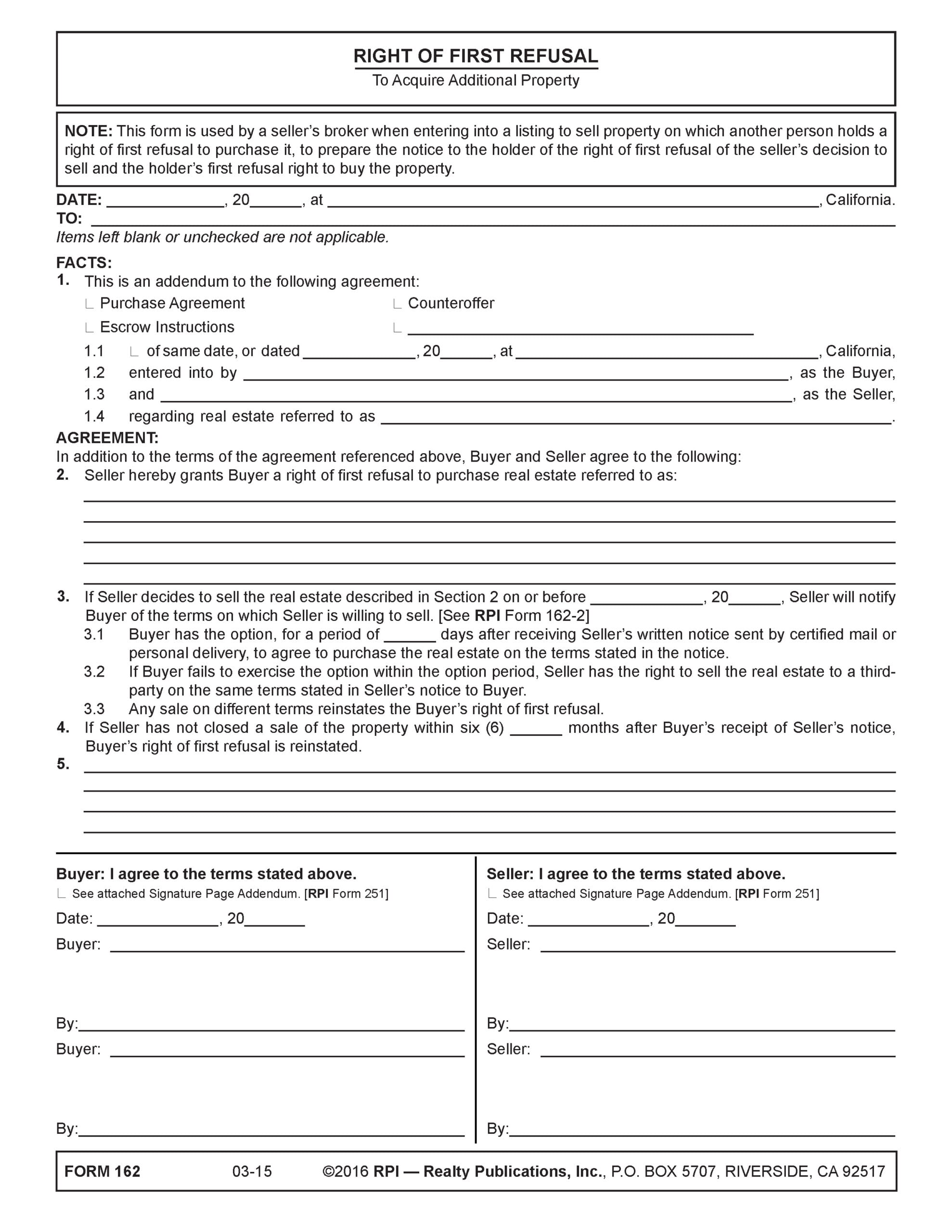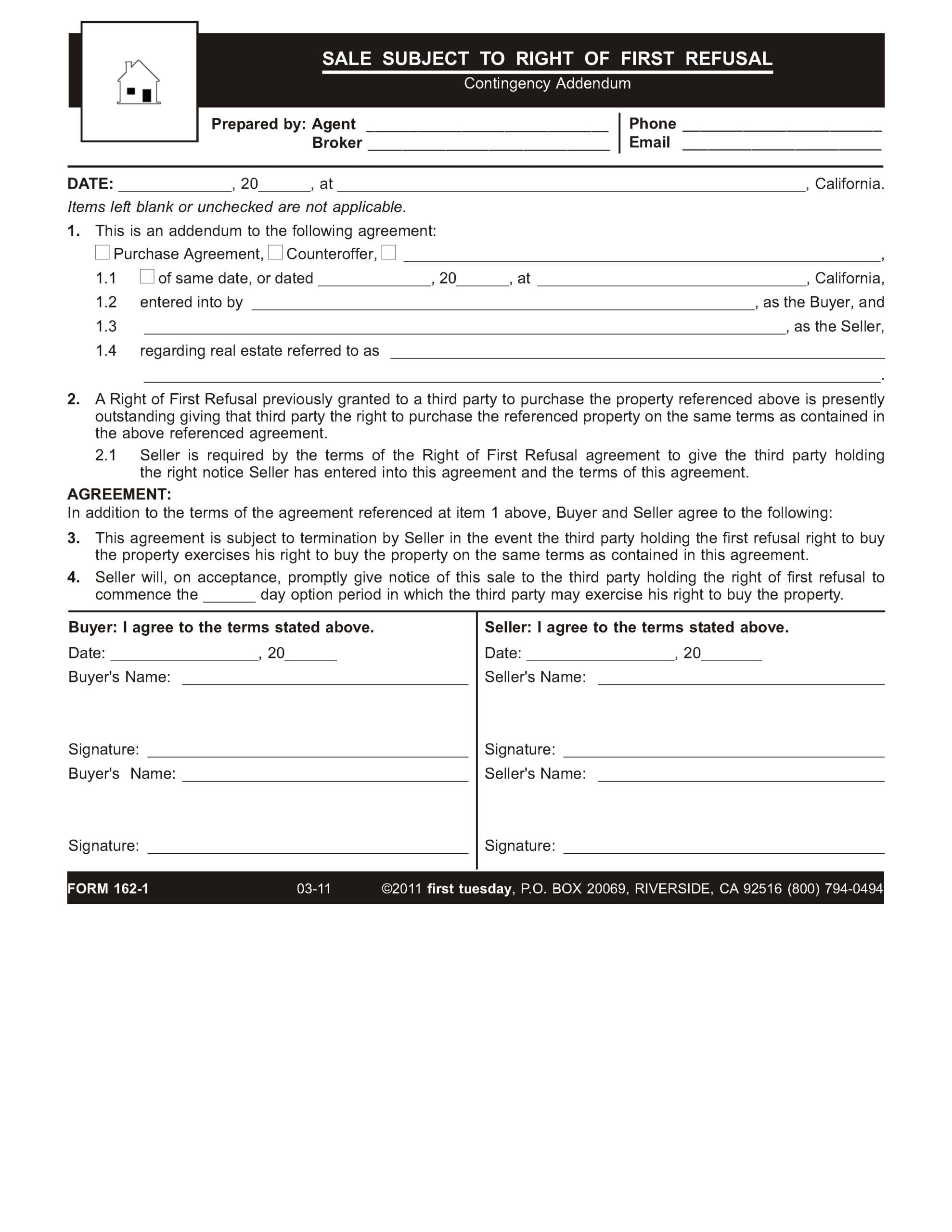The two types of right of first refusal
A right of first refusal
A right of first refusal form is usually attached as an addendum to a:
- purchase agreement [See RPI Form 150]; or
- lease agreement. [See RPI Form 550]
When attached to a purchase agreement — or, alternatively, a counteroffer or escrow instructions — the right of first refusal references a property other than the property being sold under the purchase agreement. The seller grants a right of first refusal to buy another property they own in the event they decide to sell it by using a Right of First Refusal — To Acquire Additional Property form. [See RPI Form 162]
On the other hand, when attached to a lease agreement, the right of first refusal is between the landlord and tenant. Here, the tenant is granted the pre-emptive right to buy the leased premises in the event the landlord decides to sell it. The landlord grants the tenant the right of “first dibs” to acquire the property by using the Right of First Refusal to Buy — Addendum form. [See RPI Form 579]
Related article:
Pros and cons of a right of first refusal
Before walking a client through a first refusal agreement, ask them to consider the pros and cons.
Advantages for buyers:
- priority: the buyer holds the right to the first opportunity to purchase the property when the owner decides to sell;
- obligations: the buyer does not agree to buy or otherwise acquire the property when the owner decides to sell; and
- security: the buyer has the assurance they can opt to acquire the described property when the owner decides to sell it.
Disadvantages for buyers:
- uncertainty: the buyer does not know when the owner might decide to sell, or whether the owner will ever sell the property.
Advantages for owners:
- transaction efficiency: when the buyer exercises their right of first refusal on the owner’s notice of their decision to sell, the transaction is more likely to close smoothly as the buyer has already been located and is known to the owner; and
- a safety net: the owner has greater certainty they likely have a buyer when they decide to sell.
Disadvantages for owners:
- sales options limited: the owner on deciding to sell has agreed to offer the property to the holder of the right of first refusal before unconditionally agreeing to sell it to another person; and
- delays: the owner on notifying the holder of the first refusal right of the owner’s intent to sell needs to wait for the holder to decide whether to exercise their right to purchase the property.
Related Video: Word-of-the-Week: Right of First Refusal
Click here for more information on the right of first refusal vs. the option to buy.
Analyzing the right of first refusal
A buyer’s agent uses the Right of First Refusal — To Acquire Additional Property form published by Realty Publications, Inc. (RPI) when negotiating the purchase of one property and concurrently arranging for the first refusal right to buy another property from the owner. The buyer’s agent uses the form to prepare the offer for acquiring the right of first refusal as an addendum to a purchase agreement. [See RPI Form 162]
The sections of the Right of First Refusal — To Acquire Additional Property include:
- Facts, identifying the agreement the form is attached to, the date of the agreement, the identities of the buyer and seller, and a description of the real estate [See RPI Form 162 §1];
- Provisions which grants the buyer the right of first refusal to purchase the real estate and a space to enter the description of the real estate [See RPI Form 162 §2];
- Acceptance: The time period during which the right of first refusal may be exercised [See RPI Form 162 §3];
- A reinstatement notice the buyer is to receive when the seller has not closed a sale of the property within six months after the buyer’s receipt of the owner’s notice of intent to sell which automatically reinstates the buyer’s right of first refusal [See RPI Form 162 §4];
- Space for entering additional provisions [See RPI Form 162 §5]; and
- Signatures of the buyer and seller.
Related article:
Analyzing the notice of decision to sell
A seller’s agent uses the Notice of Decision to Sell Real Estate — For Right of First Refusal form published by RPI when entering into a listing to sell property which is subject to a right of first refusal to purchase. The seller’s agent uses the form to prepare the notice to be served on the holder of the first refusal right that the seller has decided to sell and the holder may exercise their right to buy the property. [See RPI Form 162-2]
The sections of the Notice of Decision to Sell Real Estate — For Right of First Refusal include:
- Facts, which state the buyer holds the right to purchase real estate under a right of first refusal agreement, the date of the agreement and the identities of the buyer and seller [See RPI Form 162-2 §1];
- A description of the real estate [See RPI Form 162-2 §2];
- The purchase price and terms of sale [See RPI Form 162-2 §3];
- Notice of right to exercise for delivery to the holder of the first refusal right [See RPI Form 162-2 §4];
- The expiration date for the exercise period and steps the buyer is to take to exercise their right to acquire the real estate [See RPI Form 162-2 §5]; and
- Signatures of the seller and buyer, with a checkbox to indicate whether the buyer intends to exercise or reject their right of first refusal to purchase the real estate.
Related article:
Analyzing a sale subject to a right of first refusal
An agent uses the Sale Subject to Right of First Refusal — Contingency Addendum form published by RPI when negotiating with a buyer of a property on which another person holds a right of first refusal to purchase the property. [See RPI Form 162-1]
The sections of the Sale Subject to Right of First Refusal — Contingency Addendum include:
- Facts, which identify the purchase agreement the notice is attached to as an addendum, the date of the agreement, the buyer and seller’s identities and a description of the real estate [See RPI Form 162-1 §1];
- Notice of existing right of first refusal, which discloses the property is subject to a right of first refusal held by another person who may purchase the property by exercising their right to buy the property [See RPI Form 162-1 §2];
- Provisions, including:
- the purchase agreement is subject to cancellation by the seller in the event the first refusal right to buy the property is exercised [See RPI Form 162-1 §3]; and
- the seller will, on acceptance, promptly notify the holder of the first refusal that they may exercise their right to buy the property and the time period for exercise [See RPI Form 162-1 §4]; and
- Signatures of the buyer and seller.
Related article:





















